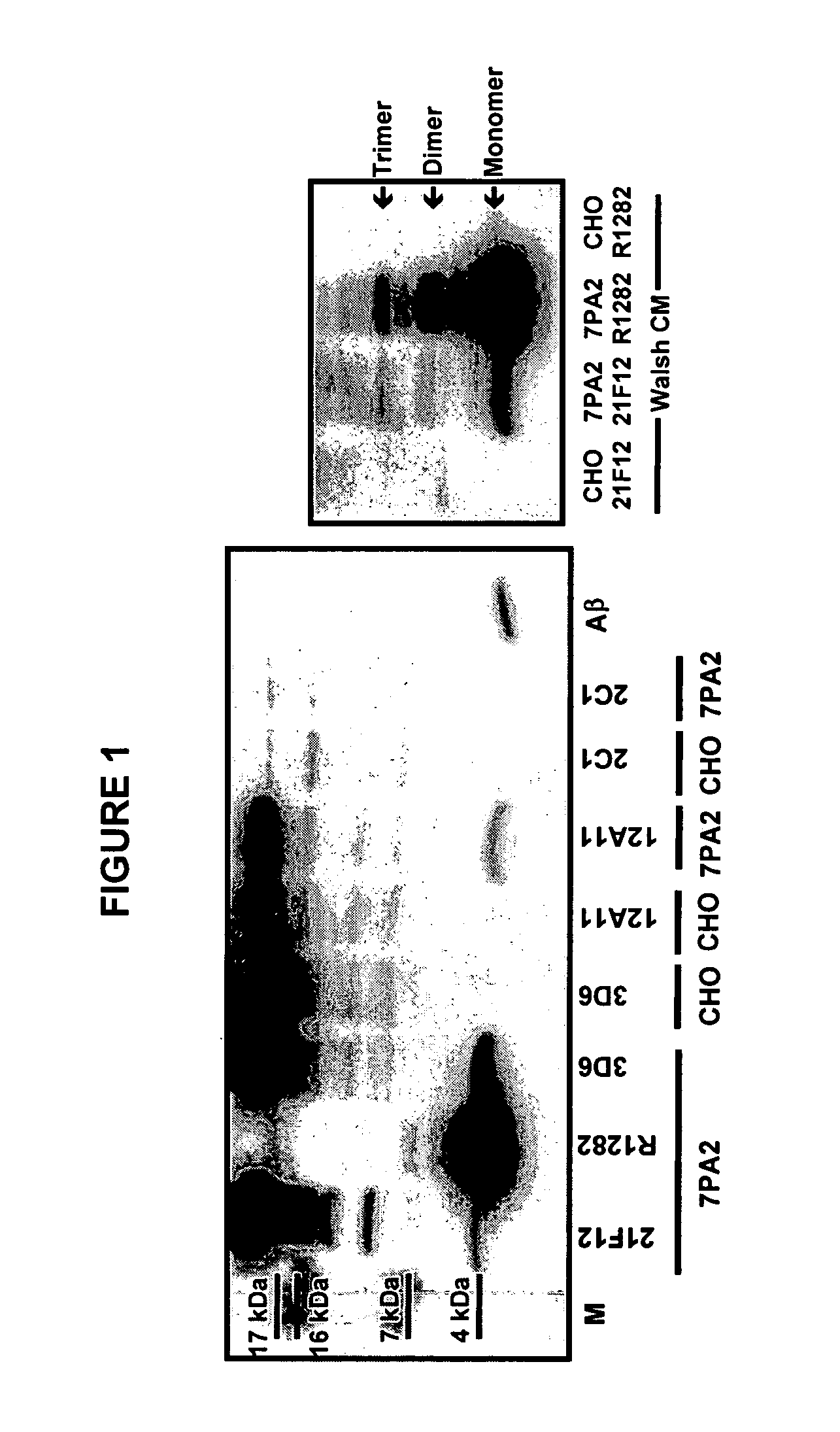Immunoprecipitation-based assay for predicting in vivo efficacy of beta-amyloid antibodies
a beta-amyloid antibody and immunoprecipitation technology, applied in the direction of biological material analysis, instruments, material analysis, etc., can solve the problems of neuronal cell death, and achieve the effects of increased binding, and rapid improvement in cognition
- Summary
- Abstract
- Description
- Claims
- Application Information
AI Technical Summary
Benefits of technology
Problems solved by technology
Method used
Image
Examples
examples
General Materials and Methods:
[0137] Preparation of Polyclonal and Monoclonal Aβ Antibodies
[0138] Anti-Aβ polyclonal antibodies were prepared from blood collected from two groups of animals. The first group consisted of 100 female Swiss Webster mice, 6 to 8 weeks of age. They were immunized on days 0, 15, and 29 with 100 μg of synthetic intact Aβ42 combined with Complete and Incomplete Freund's Adjuvants (CFA / IFA). A fourth injection was given on day 36 with one-half the dose of Aβ. Animals were exsanguinated upon sacrifice at day 42, serum was prepared and the sera were pooled to create a total of 64 ml. The second group consisted of 24 female mice, 6 to 9 weeks of age, isogenic with the PDAPP mice but nontransgenic for the human APP gene. They were immunized on days 0, 14, 28 and 56 with 100 μg of Aβ42 combined with CFA / IFA. These animals were also exsanguinated upon sacrifice at day 63, serum was prepared and pooled for a total of 14 ml. The two lots of sera were pooled. The an...
example i
Production and Characterization of Aβ Oligomers from Cell Line Sources
[0141] Aβ oligomeric species were profiled in conditioned media (CM) from cultured 7PA2 cells versus parental CHO cells. 7PA2 cells are CHO cells stably transfected with APP717V→F. To profile the Aβ oligomers, CM was prepared from cells cultured in Dulbecco's modified Eagle's medium (DMEM) with 10% fetal bovine serum (FBS). The 7PA2 CM was immunoprecipitated with Aβ antibodies and imaged via Western blotting with 6E10 (Aβ epitope 6-10). FIG. 1 depicts profiles of the Aβ species in CM from 7PA2 cells as compared to CHO cell CM. The right panel depicts CM immunoprecipitated with the mAb 21F12 (Aβ-42) or the polyclonal Ab R1282. The left panel depicts CM immunoprecipitated with the mAbs 21F12, 3D6 (Aβ1-5), 12A11 (Aβ3-7) or 2C1 (Aβ 3-7), or the pAb R1282. In the right-hand panel (from left to right) lane 1 is a CHO CM control immunoprecipitated with Aβ antibody 21F12; lanes 2 and 3 are 7PA2 CM immunoprecipitated with...
example ii
Aβ Preparations from Synthetic Aβ Peptide Sources
[0146] Aβ preparations (including monomeric Aβ and higher-ordered Aβ species) were prepared from synthetic Aβ peptide substantially as follows. Lyophilized Aβ1-42 peptide was dissolved to 1 mM in 100% HFIP and separated into aliquots in microcentrifuge tubes. The HFIP frees the source Aβ peptide from any structural history (structure obtained during the preparation, purification and / or storage of the Aβ peptide). The HFIP was removed by evaporation, and lyophilization was used to remove residual HFIP to yield an Aβ peptide residue, typically in the form of a film. The Aβ peptide residue was stored (e.g., dessicated at −20° C.) for later use in preparing the Aβ preparation or used immediately.
[0147] For use, the Aβ peptide was resuspended in dimethyl sulfoxide (DMSO). The Aβ1-42 in DMSO was added to Ham's F-12 (phenol red free) culture media to bring the peptide to a final concentration of 100 μM. The resultant solution was then incu...
PUM
 Login to View More
Login to View More Abstract
Description
Claims
Application Information
 Login to View More
Login to View More - R&D
- Intellectual Property
- Life Sciences
- Materials
- Tech Scout
- Unparalleled Data Quality
- Higher Quality Content
- 60% Fewer Hallucinations
Browse by: Latest US Patents, China's latest patents, Technical Efficacy Thesaurus, Application Domain, Technology Topic, Popular Technical Reports.
© 2025 PatSnap. All rights reserved.Legal|Privacy policy|Modern Slavery Act Transparency Statement|Sitemap|About US| Contact US: help@patsnap.com



